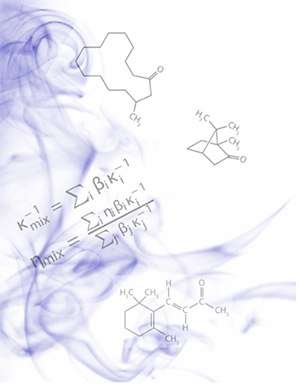
By:
- Cynthia Dillon
Published Date
By:
- Cynthia Dillon
Share This:
Scientists Sniff Out How the ‘Nose Knows’

Smells are made of mixtures of volatile compounds, which compete to bind on the limited olfactory receptors in our nose. The "activity" of an olfactory receptor is determined by how well a compound binds to the receptor and its activation efficacy after binding. Image by Venkathesh Murthy and Gautam Reddy.
One of the oldest senses to develop evolutionarily, the sense of smell allows land animals with backbones—from hound dogs to humans—to recognize food, to find a mate and to be aware of danger. In the case of hounds, such as bloodhounds and beagles, the ability to smell includes tracking a single scent amidst an environmental mashup of sensory information. This is made possible by millions of olfactory receptor cells located at the back of the nasal cavity—bloodhounds have 300 million; humans have 220 million. The sense of smell, linked to emotion and memory in humans, is a vital way for many organisms to interact with their environments. This is why researchers at the University of California San Diego are tracking a new way to “normalize” the process of specifying odors in a smell-cluttered environment.
UC San Diego physicist Massimo Vergassola, physics graduate student Gautam Reddy and the lab group of Venkatesh Murthy at Harvard explain their research in a paper titled, "Antagonism in olfactory receptor neurons and its implications for the perception of odor mixtures,” published April 24 in “eLife.” The study bears implications for future olfactory research since it recognizes a new way to analyze olfaction, which also applies to other sensory processes in the brain.
Using a biophysically motivated model of odorant receptor neurons, the researchers show that competitive interactions between odorant molecules and olfactory receptors can be used to help the brain differentiate odors within olfactory-rich environments. First, the scientists noticed that odor molecules compete to bind to an olfactory receptor. Second, they observed the bound molecule generates activity in olfactory receptor neurons less effectively than other odor molecules. In other words, different molecules in an odor mixture “antagonize” each other at the olfactory receptor neuron level. When applied to the entire receptor repertoire in our nose, the idea of competitive antagonism, or what the scientists call the “antagonistic encoding model,” keeps receptor neurons from becoming saturated and allows them to proficiently detect new odors amidst a smelly brew of odors.
This proposed theory of “normalization,” especially relevant to the visual cortex in the brain, suggests a novel mechanism for normalization in olfaction, which occurs solely through odor-receptor interactions. The results of this study emerged from a combination of theory and computation, which offer key pointers for future olfactory experiments. They also are of interest to a wider community of scientists interested in biological sensing because of the widespread necessity of filtering dominant background signals; for example, in the immune system.
The study was funded by grants from the Simons Foundation and the NIH, and by an NIH Fellowship.
The Department of Physics’ graduate program within the Division of Physical Sciences at UC San Diego is listed among the Top 20 graduate programs by U.S. News and World Report.
Share This:
You May Also Like
Stay in the Know
Keep up with all the latest from UC San Diego. Subscribe to the newsletter today.


